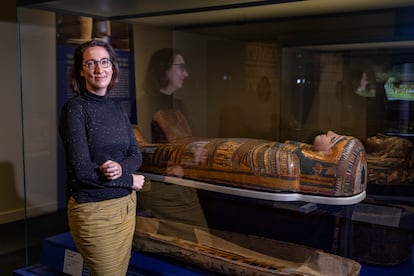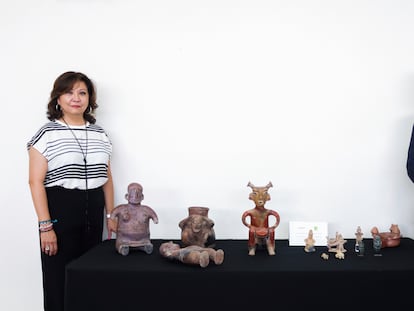British Museum curator of Egyptian exhibits prefers Brendan Fraser’s mummy movie to Tom Cruise reboot
Marie Vandenbeusch’s exhibition at Barcelona’s CaixaForum delves into the lives of six ancient people


Marie Vandenbeusch’s sunny disposition belies the occupation that requires her to spend her days surrounded by mummies as a curator in the British Museum’s Department of Ancient Egypt and Sudan. Vandenbeusch and her colleague, Daniel Antoine, the department’s chief curator, have assembled an extraordinary exhibition at the CaixaForum cultural center in Barcelona called “Mummies of Egypt: Rediscovering six lives.” The exhibit teaches museumgoers about the daily lives of Ameniryirt, Nesperennub, Penamunnbnesuttawy, Takhenemet and two unknown Egyptians.
Question. Don’t all these mummies give you the creeps?
Answer. No, I don’t find them at all sinister, if that’s what you mean. I never forget that they were once real people. Our way of looking at mummies has changed a lot in recent years. We still view them with respect, but without all the false mythologizing. They are the bodies of human beings like us, and the purpose of the exhibit is to help everyone understand that these were people, not objects. On display are six people that lived long ago, along with items that reveal their daily lives. We tried to bring the past to the present, to establish a direct connection.
Q. Tell us about the technology used to study the mummies without damaging them.
A. Yes, we used non-invasive systems – very specialized, state-of-the-art scanners. We have some new tools that help us better understand the mummies. But didn’t want the technology to detract from the experience of viewing the lives of ancient human beings. We wanted the exhibit to breathe humanity.
Q. It really is very moving to meet these ancient Egyptians.
A. I’m glad you think so. There is something unique about each one of them, and all their stories are touching.
Q. Especially the stories of the boy and the young man.
A. Yes, they are sad stories. But they show us how frequently people in Ancient Egypt died in childhood. The objects on display next to the mummies are very captivating as well. My favorite is a toy horse, very much like the one I had as a child.
Q. You’re Swiss – how did you become interested in Egypt?
A. When I was a child, a family friend got me interested in Ancient Egypt. Geneva’s Museum of Art and History, which is a bit like the British Museum, has a good Egyptian collection where many Swiss children like me discovered this civilization. I first traveled to Egypt when I was 17.
Q. Was it a shock?
A. It’s always a shock, but a wonderful one. I used to go a lot to Egypt and Sudan, and I still go regularly, but not as much as I would like. We’re excavating an archaeological site in Amara West. It’s the modern name of an ancient Egyptian city in Nubia, in what today is Sudan.
Q. Is it hard?
A. It used to be, but conditions have improved a lot. Although my first love is museums, I also love excavating because it’s a unique way of seeing where objects come from, where they were created. This is an essential experience in my line of work.
Q. The British Museum seems to be full of ancient secrets. What’s it like to work there?
A. Sorry to ruin the mystique, but it’s actually a very scientific environment. The secrets are in the objects that are being studied continuously and have much to reveal still. But there is nothing esoteric or mystical. Admittedly, I am not given to that sort of thing.
Q. That’s probably good when dealing with mummies, right?
A. I realize that movies and novels arouse interest in Ancient Egypt. I like them too if they are well done.
Q. Well, if forced to choose… Brendan Fraser’s mummy or Tom Cruise’s reboot? Imhotep or Ahmanet?
A. Ha, ha! I prefer Brendan Fraser’s – it’s funnier.
Q. Is the British Museum feeling any pressure to return relics to their countries of origin?
A. There is some debate, but there has always been discussion about this.
Q. What’s your personal opinion?
A. It depends on the object because each one has its own history. It’s a sensitive subject. Anyway, it’s not my place to say.
Q. Obligatory question – what do you think of the hypothesis that there are secret chambers in the tomb of Tutankhamun?
A. It’s an interesting hypothesis, and to be honest, there’s nothing typical about Tutankhamun’s tomb. Nothing can be ruled out. But we just have to wait and see, to be patient. And we’re always allowed to dream.
Q. How did these mummies get here? Don’t tell me that they traveled on a passenger plane.
A. Yes, so the next time you fly, think about the Egyptian mummies that may be in the cargo hold.
Q. Well, that makes me think of what happened to Tom Cruise in the movie when he had a mummy on the plane. Speaking of evil mummies, the last time we met, we were standing next to the “Unlucky Mummy” in the British Museum. What’s new with her?
A. Rest assured, there’s nothing new.
Sign up for our weekly newsletter to get more English-language news coverage from EL PAÍS USA Edition
Tu suscripción se está usando en otro dispositivo
¿Quieres añadir otro usuario a tu suscripción?
Si continúas leyendo en este dispositivo, no se podrá leer en el otro.
FlechaTu suscripción se está usando en otro dispositivo y solo puedes acceder a EL PAÍS desde un dispositivo a la vez.
Si quieres compartir tu cuenta, cambia tu suscripción a la modalidad Premium, así podrás añadir otro usuario. Cada uno accederá con su propia cuenta de email, lo que os permitirá personalizar vuestra experiencia en EL PAÍS.
¿Tienes una suscripción de empresa? Accede aquí para contratar más cuentas.
En el caso de no saber quién está usando tu cuenta, te recomendamos cambiar tu contraseña aquí.
Si decides continuar compartiendo tu cuenta, este mensaje se mostrará en tu dispositivo y en el de la otra persona que está usando tu cuenta de forma indefinida, afectando a tu experiencia de lectura. Puedes consultar aquí los términos y condiciones de la suscripción digital.
More information
Archived In
Últimas noticias
Welcome to the post-religion era: The idea of Christianity as the absolute truth has become obsolete
‘I thought you would like it’: The risky sexual practice popularized by TV shows and TikTok
The digitalization of tourism: ‘They promise experiences and gave us the worst possible one’
Mexican peso defies uncertainty with forecasts of a new period of stability in 2026
Most viewed
- Sinaloa Cartel war is taking its toll on Los Chapitos
- Oona Chaplin: ‘I told James Cameron that I was living in a treehouse and starting a permaculture project with a friend’
- Reinhard Genzel, Nobel laureate in physics: ‘One-minute videos will never give you the truth’
- Why the price of coffee has skyrocketed: from Brazilian plantations to specialty coffee houses
- Silver prices are going crazy: This is what’s fueling the rally










































